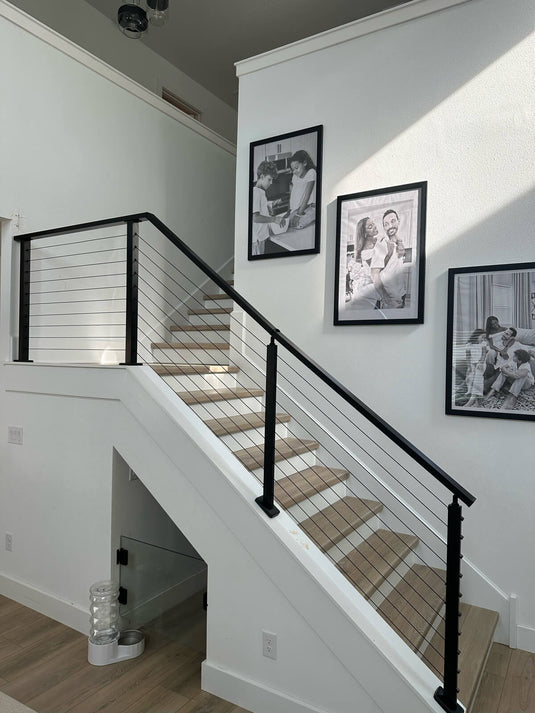TABLE OF CONTENTS
DIY Railing: Must-Know Regulations Before You Start
When planning a DIY cable railing project for your deck, porch, or stairs, understanding the applicable building codes is critical to ensure safety, compliance, and a smooth inspection process. The International Residential Code (IRC) 2024 sets the standard for residential railing requirements, including residential railing code, deck railing code, railing code requirements, porch railing height, and deck handrail code. Since local jurisdictions may adopt the IRC with amendments, always verify with your local building department.
This guide outlines the key regulations, compliance strategies, self-inspection tips, common mistakes, and remedies to help you navigate your DIY project.

Photo Credit: Thomas Paine / Muzata Customer
What Codes and Strategies Apply to Different Areas?
Below, we break down the IRC 2024 requirements for three key installation areas—decks, porches, and stairs—focusing on how cable railings can meet these standards. For each area, we specify the relevant codes and recommend installation methods (surface-mounted or side-mounted) to ensure compliance.
1. Decks & Porches
|
Code Requirements (IRC 2024, Section R321.1) |
|
|
Where Required(R321.1.1) |
Guards are required for decks and porches more than 30 inches above the floor or grade below, measured vertically within 36 inches horizontally from the edge.  |
|
Height (R321.1.2) |
Guards must be at least 36 inches high, measured vertically from the deck or porch surface or fixed seating (e.g., built-in benches).  |
|
Opening Limitations (R321.1.3) |
Openings between cables must not allow a 4-inch sphere to pass through.  |
|
Load Requirements (R301.5, R321.1.4) |
Guards must withstand a 200-pound concentrated load in any direction along the top without failure or excessive deflection. |
|
Cable Railing Strategies |
|
|
Surface-Mounted Posts |
|
|
Side-Mounted Posts |
|
|
Cable Spacing |
Maintain an appropriate cable spacing to ensure a 4-inch sphere cannot pass through. Use tensioning hardware to maintain tight cables and prevent deflection. |
2. Stairs
|
Code Requirements (IRC 2024, Sections R321.1, R320, R318.7.8) |
|
|
Where Required (R321.1.1, R318.7.8) |
Guards are required for open-sided stairs more than 30 inches above the floor or grade below. Handrails are required on at least one side of stairways with four or more risers.  |
|
Height (R321.1.2, R320.2) |
Stair guards must be at least 34 inches high, measured vertically from the line connecting the tread nosings. Handrails must be 34–38 inches high from the nosing line. If the guard top serves as a handrail, it must meet the 34–38-inch handrail height.  |
|
Opening Limitations (R321.1.3) |
Openings in stair guards must not allow a 4 3/8-inch sphere to pass through, except in the triangular area formed by the tread, riser, and bottom rail, where a 6-inch sphere is permitted.  |
|
Handrail Graspability (R320.6) |
Handrails must have a circular cross-section (1.25–2 inches diameter) or equivalent graspability for non-circular shapes. |
|
Handrail Continuity (R320.5) |
Handrails must be continuous for the full length of the stair flight, with returns to walls or posts at ends. |
|
Load Requirements (R301.5) |
Both guards and handrails must withstand a 200-pound concentrated load. |
|
Cable Railing Strategies |
|
|
Surface-Mounted Posts |
Common for stair guards, as they align with the stair tread surface and provide stable anchoring. Ensure posts are securely fastened to the stair stringers or framing. |
|
Side-Mounted Posts |
Used for stairs with limited tread width or to maintain a clean stair edge. Side-mounting requires precise attachment to the stair stringer to meet load requirements. |
|
Cable Spacing |
Space cables 3.5 inches or less apart for general guard areas and ensure the triangular area (tread, riser, bottom rail) allows no more than a 6-inch sphere to pass. |
|
Handrail Compliance |
Install a separate graspable handrail (1.25–2 inches diameter) at 34–38 inches above the nosing line. The top of a cable guard cannot typically serve as a handrail unless it meets graspability requirements. |
|
Height Compliance |
Ensure stair guards reach at least 34 inches, with the handrail at 34–38 inches. For cable systems, the top rail must meet the handrail height if it doubles as the handrail. |
How to Self-Inspect for Compliance?
According to IBC, "Construction or work for which a permit is required shall be subject to inspection by the building official and such construction or work shall remain visible and able to be accessed for inspection purposes until approved. Approval as a result of an inspection shall not be construed to be an approval of a violation of the provisions of this code or of other ordinances of the jurisdiction. Inspections presuming to give authority to violate or cancel the provisions of this code or of other ordinances of the jurisdiction shall not be valid. It shall be the duty of the owner or the owner's authorized agent to cause the work to remain visible and able to be accessed for inspection purposes."
Therefore, before scheduling a building inspection, use this checklist to verify your cable railing installation meets IRC 2024 requirements:
1. Height:
- Decks/Porches: Top rail or cable is at least 36 inches above the walking surface or fixed seating.
- Stairs: Guard height is at least 34 inches above the nosing line; handrail height is 34–38 inches.
2. Cable Spacing:
- Openings between cables do not allow a 4-inch sphere to pass (3.5-inch spacing or less).
- For stair guards, the triangular area (tread, riser, bottom rail) allows no more than a 6-inch sphere.
3. Load Resistance:
- Posts, cables, and anchors can withstand a 200-pound concentrated load in any direction without failure or excessive deflection. Test by applying firm pressure or consult manufacturer specifications.
4. Handrail Graspability (Stairs):
- A separate handrail with a 1.25–2-inch diameter (or equivalent graspability) is installed on at least one side of stairs with four or more risers.
- Handrail is continuous for the full stair flight, with returns at ends.
5. Clearance and Projection
- Handrails have at least 1.5 inches of clearance from walls (R320.4).
- Handrails project no more than 4.5 inches (or 6.5 inches with exceptions) into the stairway (R320.3).
6. Local Compliance:
- Verify with your local building department for amendments (e.g., 42-inch guard height for multi-family dwellings in some jurisdictions like Hampton, NH).
- Obtain required permits and schedule inspections (per IRC Section 105 and local rules).
7.Material Approval:
- Use materials approved by the building official (e.g., plastic composite handrails compliant with R507.2.2 for exterior use) (R320.7, R104.9).
What Are Common Cable Railing Mistakes & Remedies?
|
Mistake |
Remedy |
|
Cables spaced too far apart (>3.5 inches), allowing a 4-inch sphere to pass. |
Adjust cable tension or add intermediate cables/posts to reduce spacing to 3.5 inches or less. Retest with a 4-inch ball. |
|
Guard or handrail height too low (<36 inches for decks/porches, <34 inches for stair guards, or <34–38 inches for handrails). |
Raise the top rail or add a higher post/rail to meet the minimum height. Recheck measurements from the walking surface or nosing line. |
|
Using the top of a cable guard as a handrail without meeting graspability requirements. |
Install a separate graspable handrail (1.25–2 inches diameter) at 34–38 inches above the stair nosing. |
|
Inadequate post strength, failing the 200-pound load test. |
Replace with stronger posts (e.g., 4x4 or metal) or reinforce with additional anchors/bolts. Consult a structural engineer if needed. |
|
Skipping permits or inspections. |
Contact your local building department to apply for a permit retroactively and schedule an inspection. Be prepared for potential rework if non-compliant. |
|
Ignoring local amendments (e.g., 42-inch guard height in multi-family units). |
Check local codes via municipal websites (e.g., www.chicago.gov, www.hamptonnh.gov) or contact the building department to confirm requirements. |
Conclusion

Photo Credit: Steve Kelly / Muzata Customer
Installing cable railings for your deck, porch, or stairs requires adherence to the IRC 2024 standards to ensure safety and compliance. Key requirements include a 36-inch guard height for decks and porches, 34–38-inch handrail height for stairs, 4-inch maximum cable spacing, and 200-pound load resistance. Surface-mounted posts are generally easier for DIY installations, while side-mounted posts offer aesthetic flexibility but require robust anchoring. Use the self-inspection checklist to verify compliance, and address common mistakes like improper spacing or inadequate handrails promptly. Always check with your local building department for IRC 2024 adoption, permits, and any amendments (e.g., 42-inch guards in some jurisdictions). For further details, access the IRC 2024 at International Code Council or consult your local building office.
Start your DIY cable railing project today by reviewing the full IRC guidelines and contacting your local building department to ensure a safe, compliant installation!
📌Consult with muzata designer for personalized advice now!




